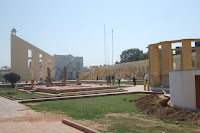
Travel Dates 15-18 March 2008
My apologies. I can't believe it is over four months since I last posted on this travel blog. I've made a New Year's resolution to spend more time here before the memories fade.
Where was I? Ah - India!
It took over an hour to leave Agra. At one point we inched along in a grid-lock of cars, bikes, pedestrians, scooters, auto-rickshaws, camels and donkeys; moving ten feet in twenty minutes. It was only when a policeman finally appeared (I think it was to usher a cow through) that we finally got moving again
After the chaos and grime of Agra we visited Fatehpur Sikri then crossed the border from Uttar Pradesh into Rajasthan. I'll come back to Fatehpur Sikri later, when I write on some of the other forts and palaces in the region, such as Amber Fort.
The change was quite abrupt, in many small but noticeable ways. The road was better maintained and although the drivers were just as crazy the traffic was a little lighter. The villages beside the road were still poor, but clean and tidy and better cared for. One of the contradictions I noticed as we drove past those villages was the poise and grace of the women and the wonderful colours of their saris and the variety of their jewellery. Possibly their posture was aided by the habit of carrying quite heavy loads balanced on their heads.
We saw several groups working in the fields, but the most noticeable village industry seemed to be dung production in the form of dinner-plate sized discs. The finished items are left in the sun to dry, then stacked in piles like giant beehives; often the stacking is done in a decorative spiral.
Despite that, even when I noticed the ladies carrying loads of the stuff on their heads, their clothing always looked spotless. Presumably the source of the product is the cows, camels and goats or even elephants that we regularly swerved to avoid, but I didn't ask the driver for more detail. There are some questions you don't really want answers to.

We arrived in Jaipur and I checked into Hotel Arya Niwas, as I mentioned in the previous post.


Jaipur, after Agra, was a much more pleasant city. I felt quite comfortable wandering alone in the roads near the hotel and also downtown later when I went shopping.


However, by Australian standards the traffic was still chaotic.


I learned as a pedestrian that the only function of pedestrian crossings was to channel all the targets for the motorists into one area; woe betide any pedestrian still on the crossing when the lights changed. I was actually quite proud of myself at one stage, when I realised that I had crossed the road seven times without injury. Of course, on the eighth crossing I was grazed by a car. It must have been my fault, from the reaction of the driver; he was probably right. Silly me for thinking he was supposed to stop when the light went red...


The people of the "Pink City", Jaipur, are proud of their heritage as the capital of Rajasthan; certainly my driver, Raj, was.


It is a sprawling city, surrounding the central "Old Town" which includes the famous Observatory and several palaces including the City Palace, which is now effectively a museum, and the fascinating Hawa Mahal.


This palace is effectively a facade one room thick but five stories high. It was built in the late 18th century in the form of the crown of the Hindu god Krishna as a place where the Maharaja's royal ladies could gaze out without being seen. So this was their view of the world. As I arrived on the fifth floor this procession was passing; I'm not sure what was being celebrated. The place is being renovated at the moment. Once again I was impressed by the bravery of the Indian workers and their faith in the bamboo and rope scaffolding five floors up.


The observatory was impressive. Built by Maharaja Sawai Jai Singh II, the Rajput ruler of Amber, in the early 18th century it is an amazingly accurate celestial observatory. Most of the structures are shadow-dials of one form or another, designed to track the progress of the sun, moon and the astrological constellations of the zodiac. It served as local clock, calendar and the ruler's predictor and guide. Astrology was considered an important science at the time.


Click on the text photos for descriptions for the associated photos. The large picture above is a reverse view of the Brihat Samrat Yantra, the giant sundial.













Cheers, Alan



No comments:
Post a Comment